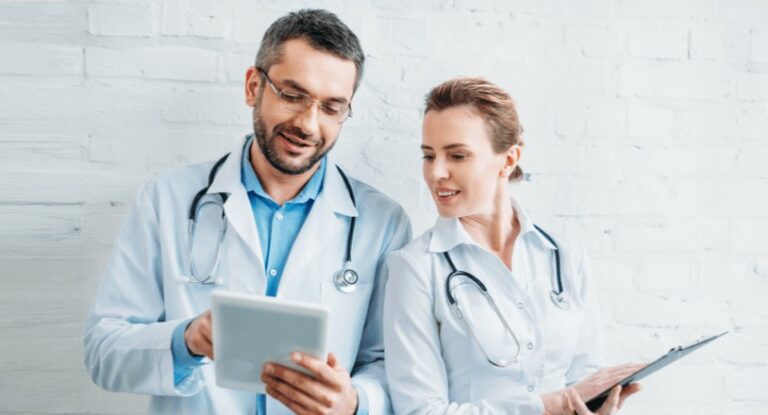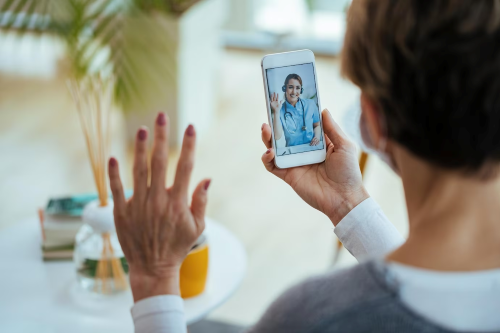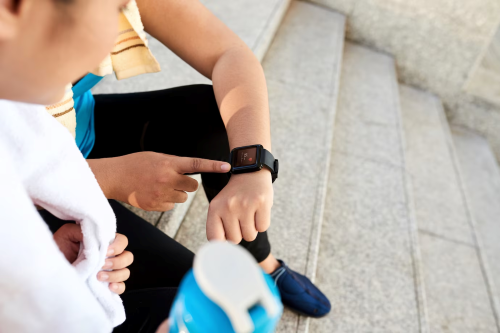- Publish and update apps & content
- Remotely control and manage attended or unattended devices
- Real-time location tracking
- Enable Healthcare to meet HIPAA compliant for patient privacy data protection
- Improve response time with 24/7 device monitoring
The Remote Monitoring Revolution in Healthcare
The last several years have changed how the world views health and wellness. These areas of life have gained newfound importance and are now also achieved differently than before the pandemic.
Take the hospital as an example. A hospital used to be where patients had to go physically. The sick or injured patient would get dressed, commute to the hospital site, and wait in the right clinic to see the doctor. This paradigm was upended by telemedicine: Now, patients could consult with that same doctor via video call, telephone call, or even chatting.
Telemedicine can be further enhanced by wearables, Internet-of-Things devices, and other gadgets, such as fitness trackers, smart scales, shoes, and wearable heart monitors.
Telemedicine and smart devices for remote monitoring address some of the core problems with face-to-face healthcare.
- 1 :Purely face-to-face healthcare presents health risks to patients
- Face-to-face healthcare promotes a false binary of health
- Face-to-face healthcare limits the amount of data available on patients
- 2 :How remote monitoring in healthcare is better?

- 3 :Why remote monitoring for healthcare is needed now?
- 4 :Final words
Purely face-to-face healthcare presents health risks to patients
This fact was most evident during the pandemic. People who may have had a non-life threatening illness visited the hospital, caught COVID-19 from airborne germs, and fell seriously ill or even died.

This threat is not only limited to viruses like COVID-19. Because hospitals are filled with people suffering from all illnesses, they are high-risk environments. Patients who go to them may be exposed to other illnesses when their initial ailment already compromises their immune system. Hospitals, clinics, and other healthcare settings may undermine the health outcomes they seek.
Face-to-face healthcare promotes a false binary of health
When a hospital or clinic is a place a patient must visit to get better, people often adopt a false dichotomy of health. They may believe that a person is either sick and needs a doctor or is healthy and does not need one.
This belief is a dangerous one. Health, after all, is not an on-off switch. True health and wellness are more akin to a continuum. All people should strive to practice positive behaviors regularly, such as getting proper nutrition, exercising regularly, sleeping well, and keeping stress in check.
Face-to-face healthcare limits the amount of data available on patients
Data is limited when people only see healthcare professionals when they are ill. The healthcare provider will only get snapshots of a person’s overall health profile, and these will be at irregular intervals.
For example, a doctor may have data on the resting heart rate of a patient every six months to a year, even though the person may be at high risk for certain cardiovascular or respiratory ailments. If their resting heart rate spikes between visits, the patient will have no idea, and their doctor will be none the wiser.
For healthcare data to be useful, healthcare professionals must have a continuous feed. Gaining a richer pool of information would enable them to draw deeper insights and make better recommendations.
How remote monitoring in healthcare is better?
Most people think of remote health monitoring devices such as fitness trackers, wearable heart monitors, smart scales, and other health gadgets as personal items: They help users track their health journey. While they can certainly be used exclusively this way, they are even more powerful when paired with an MDM like AirDroid Business.
Pairing remote patient monitoring devices with an MDM allows users to extend access to their healthcare professionals, doctors, psychologists, nutritionists, or other specialists. There are numerous advantages to sharing information with these experts.

AirDroid Business MDM for Healthcare
Effciently manage a large number of medical mobile devices and update applications, regularly track device abnormal conditions to provide timely remote support, and strengthen the data security protection of patients and hospitals.
Remote monitoring for healthcare reduces risks
The most obvious benefit of remote monitoring is safety. Like telemedicine; patients will not need to visit a hospital or healthcare setting for a check-in or consultation. Instead, they can simply provide the information via their corresponding device with various applications.
A person who has insomnia can provide the sleep patterns documented via their smartwatch to their doctor. An obese person can share the weight fluctuations observed by their smart scale.
A smoker at risk for cardiovascular problems can give access to their heart data. All of this information-sharing spares them the trip to the hospital, which could expose them to more serious ailments than they came in the first place for.
Remote monitoring also protects patients from an unexpected risk: themselves. With telemedicine alone, patients may white lie, fearing how their doctor will view them.
The obese person may fib that he is following the recommended diet and exercise program, while the smoker may proclaim that he has quit smoking cold turkey.
Unlike people, devices that allow remote monitoring cannot lie. Given that an MDM like AirDroid Business can monitor device behavior, easily configure permissions, and implement cyber security best practices, patients cannot falsify data on the health device, which is surprisingly common (alcoholics who have breathalyzers installed on their cars for vehicle ignition will often ask someone else to blow into the device, for example).
Because health devices backed by an MDM are effectively tamper-proof, healthcare professionals will have an accurate picture of the person’s health, no matter what they say.
This ability improves the health outcomes of telemedicine: Healthcare professionals have more data to gauge the true state of their patient’s well-being.
Remote monitoring for healthcare transforms healthcare into a continuum
Remote monitoring transforms healthcare so that it is no longer a binary between being sick and needing a doctor or being healthy and not needing one. Now patients can be monitored across their entire journey to improve health outcomes.
This remote monitoring is helpful for two key reasons. When patients realize they are being observed, they practice healthier behaviors. This phenomenon is known as the Hawthorne effect, and it has been observed across diet, exercise, and other health habits.
When people know their sleep is being remotely monitored, they may practice better sleep hygiene rather than stay up to scroll on their smartphones.
When people know what they eat will be reflected on their smart scale, they will avoid junk foods and stick to the diet recommended by their physician. When smokers know their heart rate is being remotely observed, they will not try to take one last cigarette. People want to do even better, in short, when others are watching.

Remote monitoring is also helpful for healthcare professionals. Rather than only seeing patients when they are suffering from an ailment, doctors can obtain a continuous, long-term view of how they are doing.
This visibility allows them to stage interventions much sooner. A doctor who sees that their obese patient is still gaining weight can provide additional recommendations. These earlier interventions are preferable to the alternative: The patient gets advice when it is too late, more damage has been done, or the situation becomes even harder to reverse. Remote monitoring, in short, is equivalent to efficient monitoring.
Skeptics might argue that remote monitoring is only as good as the devices. These gadgets, after all, will run out of battery, glitch, or fail to update, and any of these issues could bring about a protracted downtime, during which healthcare professionals get no data.
An MDM like AirDroid Business effectively combats this problem: Because they enable remote access - even of unattended devices - IT teams can ensure they always remain online, updated, and in working order, preserving the continuous stream of patient data.
Remote monitoring for healthcare provides valuable data without any distraction
Another big risk with remote monitoring through devices is misused. For example, a patient issued a tablet to record their meal entries may instead use the device to surf the web and perhaps even order junk food - subverting its original purpose.
Instead of using the tablet to monitor their sleep performance tracked via their fitness tracker, a person with insomnia may also use the device to web surf late into the night, worsening their condition.

Fortunately, an MDM can assist with these issues as well. AirDroid Business has kiosk mode, which enables organizations to lock down usage to certain apps, allowlist websites, and even imprint their brand identity via different assets.
For healthcare organizations, kiosk mode is invaluable: It ensures patients use devices only as their doctors intended. This way, there are no unintended consequences from device misuse, and patients can focus on tasks necessary to improve their well-being.
For their part, doctors get the valuable data they need without interruptions. They can rest assured knowing that devices will not unintentionally complicate or worsen a person’s ailment and that the data reflects their best efforts toward better health. Kiosk mode, in short, serves as an additional safeguard, policing patients when doctors are not available to ensure compliance.
Why remote monitoring for healthcare is needed now?
When most people think of remote monitoring for healthcare, they may assume that the primary benefit is convenience. Patients don’t have to go to hospitals for every ailment, and physicians won’t have many people waiting outside their doors.
In actuality, convenience is only a secondary benefit. When paired with an MDM like AirDroid Business, devices that enable remote monitoring are creating a true revolution in healthcare.
Remote monitoring reduces risks, such as the need to visit healthcare settings that may be teeming with germs, and the possibility of patients tampering with the device, since they are secured via provisioning, analytics on device behavior, and cybersecurity best practices.
Remote monitoring upends the view of health from the false dichotomy of being sick or well by providing continuous data on a person’s well-being. This data stream is protected by the remote access function of an MDM, which can ensure that devices will always be in working order.
Finally, kiosk mode will ensure compliance so patients use devices only as intended and in line with the positive health behaviors their physicians wish to promote.
Final words
Remote monitoring, in short, will usher in a new era of wellness, one that forward-thinking physicians, clinics, hospitals, and other healthcare providers should strive to be at the forefront of.
Remote patient monitoring devices are helpful for two reasons. Many of these devices have built-in features to automatically alert users and any stakeholders, such as medical staff, of any risks, such as sudden weight gain or poor sleep. In addition to this feedback, healthcare professionals gain much richer data to draw deeper insights and make better recommendations.






Leave a Reply.